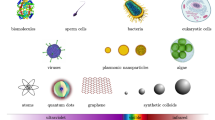Abstract
Magneto-optic effects are widely applied in the analysis of magnetic thin films. Specifically, due to its local probing characteristic, sensitivity, and experimental simplicity, the surface magneto-optic Kerr effect has been shown to be very useful in the investigation of the magnetization structure of materials. In this work, we propose a weak measurement-based protocol to enhance the pointer deflection, namely the polarization rotation of an incident light beam upon reflection from a magnetic surface, in some orders of magnitude, without loss in precision. It could provide a new insight into magnetic research.

Similar content being viewed by others
References
Z.Q. Qiu, S.D. Bader, Rev. Sci. Instrum. 71, 1243 (2000)
J.M.D. Coey, Magnetism and Magnetic Materials, 1st edn. (Cambridge University Press, Cambridge, 2009)
T. Katayama, Y. Suzuki, H. Awano, Y. Nishihara, N. Koshizuka, Phys. Rev. Lett. 60, 1426 (1988)
Y. Suzuki, T. Katayama, S. Yoshida, K. Tanaka, K. Sato, Phys. Rev. Lett. 68, 3355 (1992)
Y. Aharonov, D.Z. Albert, L. Vaidman, Phys. Rev. Lett. 60, 1351 (1988)
B.L. Bernardo, S. Azevedo, A. Rosas, Phys. Lett. A 378, 2029 (2014)
R.M. Camacho, P.B. Dixon, R.T. Glasser, A.N. Jordan, J.C. Howell, Phys. Rev. Lett. 102, 013902 (2009)
J. von Neuman, Mathematical Foundations of Quantum Mechanics (Princeton University Press, Princeton, NJ, 1955)
A.G. Kofman, S. Ashhab, F. Nori, Phys. Rept. 520, 43 (2012)
D.R. Solli, C.F. McCormick, R.Y. Chiao, S. Popescu, J.M. Hickmann, Phys. Rev. Lett. 92, 043601 (2004)
P.B. Dixon, D.J. Starling, A.N. Jordan, J.C. Howell, Phys. Rev. Lett. 102, 173601 (2009)
O. Hosten, P. Kwiat, Science 319, 787 (2008)
J.J. Sakurai, Modern Quantum Mechanics (Addison-Wesley, Redwood City, 1985)
Y. Kedem, L. Vaidman, Phys. Rev. Lett. 105, 230401 (2010)
S.M. Barnett, D.T. Pegg, Phys. Rev. A 41, 3427 (1990)
G. Baym, Lectures on Quantum Mechanics (Benjamin, New York, 1969)
I.M. Duck, P.M. Stevenson, E.C.G. Sudarshan, Phys. Rev. D 40, 2112 (1989)
S. Pang, J. Dressel, T.A. Brun, Phys. Rev. Lett. 113, 030401 (2014)
X.-Y. Xu, Y. Kedem, K. Sun, L. Vaidman, C.-F. Li, G.-C. Guo, Phys. Rev. Lett. 111, 033604 (2013)
I. Shomroni, O. Bechler, S. Rosenblum, B. Dayan, Phys. Rev. Lett. 111, 023604 (2013)
P. Ginzburg, M. Shalyt, A. Hayat, M. Orenstein, J. Phys. B 43, 105502 (2010)
G. Vrijsen, D. Gaultney, K.M. Hudek, L. Isabella, and J. Kim, Measuring the photonic frequency qubit generated by an 171Yb+ Ion in a surface trap. In: CLEO Conference Paper (2014)
E. Mount, S. Baek, M. Blain, D. Stick, D. Gaultney, S. Crain, R. Noek, T. Kim, P. Maunz, J. Kim, New J. Phys. 15, 093018 (2013)
E. Hecht, Optics, 2nd edn. (Addison-Wesley, Reading, MA, 1987)
D.J. Starling, P.B. Dixon, A.N. Jordan, J.C. Howell, Phys. Rev. A 80, 041803(R) (2009)
Y. Kedem, Phys. Rev. A 85, 060102(R) (2012)
P. Egan, J.A. Stone, Opt. Lett. 37, 4991 (2012)
A.N. Jordan, J. Martinez-Rincon, J.C. Howell, Phys. Rev. X 4, 011031 (2014)
J. Dressel, M. Malik, F.M. Miatto, A.N. Jordan, R.W. Boyd, Rev. Mod. Phys. 86, 307 (2014)
D.J. Starling, P.B. Dixon, N.S. Williams, A.N. Jordan, J.C. Howell, Phys. Rev. A 82, 011802(R) (2010)
S. Blundell, Magnetism in Condensed Matter, 1st edn. (Oxford University Press, Oxford, 2001)
N.J. Cerf, C. Adami, P.G. Kwiat, Phys. Rev. A 57, 1477(R) (1998)
Acknowledgments
This work was supported by Conselho Nacional de Desenvolvimento Científico e Tecnológico (CNPq).
Author information
Authors and Affiliations
Corresponding author
Appendix: Post-selecting a frequency qubit
Appendix: Post-selecting a frequency qubit
Our protocol is based on the post-selection of an arbitrary frequency qubit (filtering process). In doing so, after the weak interaction between the frequency and polarization degrees of freedom, if a prism is used to spatially separate the photons in the states \(\left| {\omega _{1}} \right\rangle\) and \(\left| {\omega _{2}} \right\rangle\), and a phase shift \(\varphi\) is applied in the path \(\left| {2} \right\rangle\), we obtain the entangled state
Now, if these two paths are recombined in a symmetric beam splitter (See Fig. 2), the transformations \(\left| {1} \right\rangle \rightarrow \frac{1}{\sqrt{2}} \left( \left| {1^{'}} \right\rangle + i\left| {2^{'}} \right\rangle \right)\) and \(\left| {2} \right\rangle \rightarrow \frac{1}{\sqrt{2}} (i\left| {1^{'}} \right\rangle + \left| {2^{'}} \right\rangle )\) take place, where \(\left| {1^{'}} \right\rangle\) and \(\left| {2^{'}} \right\rangle\) represent the two output modes of the beam splitter [32]. After this stage, we obtain the state
Then, if, after the weak interaction, we apply a phase shift in the path \(\left| {2} \right\rangle\) given by
and select only the photons emerging from the output mode \(\left| {1^{'}} \right\rangle\) of the beam splitter, the post-selected state, \(\left| {\psi _{f}} \right\rangle = (1/\sqrt{2}) [(\cos \alpha + \sin \alpha )\left| {\omega _{1}} \right\rangle - (\cos \alpha - \sin \alpha )\left| {\omega _{2}} \right\rangle ]\), necessary for obtaining the amplification factor of Eq. (18), is accomplished.
A symmetric beam splitter, with input modes \(\left| {1} \right\rangle\) and \(\left| {2} \right\rangle\) and output modes \(| {1^{'}} \rangle\) and \(| {2^{'}} \rangle\), operates according to the relation \(\hat{B} = | {1^{'}} \rangle \left\langle {1} \right| + | {2^{'}} \rangle \left\langle {2} \right| + i(| {1^{'}} \rangle \left\langle {2} \right| + | {2^{'}} \rangle \left\langle {1} \right| )\). This device acts as a fundamental ingredient in the post-selection (filtering) process of a frequency qubit
Rights and permissions
About this article
Cite this article
de Lima Bernardo, B. Signal enhancement of magneto-optical Kerr effect measurements by weak value amplification. Appl. Phys. B 117, 1099–1105 (2014). https://doi.org/10.1007/s00340-014-5931-x
Received:
Accepted:
Published:
Issue Date:
DOI: https://doi.org/10.1007/s00340-014-5931-x





